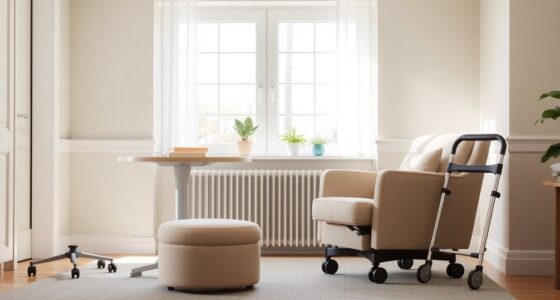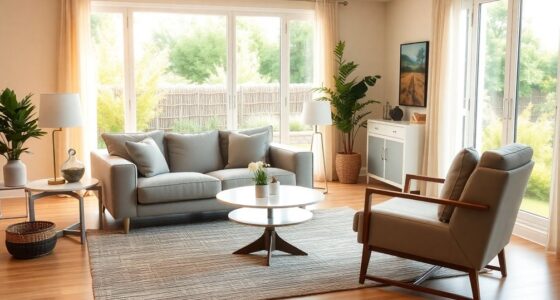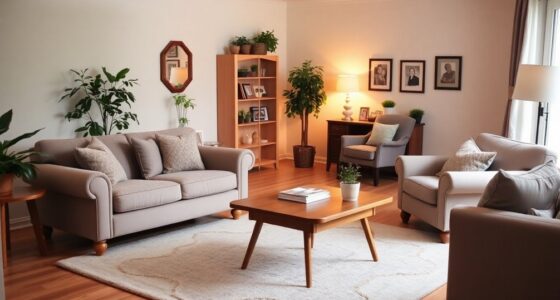If you want a space that feels safe, calm, and connected, define your rooms to create clear boundaries, reduce noise, and boost privacy. An open plan offers a bright, airy atmosphere that fosters social interaction but can feel overwhelming or less peaceful. Consider what matters most to you—privacy or openness—since each option has its benefits and drawbacks. To discover more about balancing safety, calmness, and style, explore the details ahead.
Key Takeaways
- Defined rooms offer better noise control and privacy, reducing stress and creating a calmer environment.
- Open plans promote natural light and airflow, which can enhance safety by improving visibility and ventilation.
- Walls in defined rooms help contain clutter and limit distractions, contributing to a safer, more organized space.
- Open layouts facilitate social interaction and quick access during emergencies, increasing overall safety.
- Closed rooms can provide a sense of enclosure and calmness, reducing feelings of exposure and promoting mental well-being.

When designing a home, choosing between open plans and defined rooms is a crucial decision that impacts your daily life and how your space functions. You want a layout that feels safe, calming, and suits your lifestyle. Open plans create a sense of spaciousness, allowing natural light to flow freely and making your home feel larger. They promote social interactions, so whether you’re entertaining guests or spending quality time with family, everyone stays connected. However, this openness can sometimes lead to noise and clutter becoming overwhelming, especially if you prefer a more private, tranquil environment. Without walls separating areas, sound travels easily, making it harder to find quiet time or concentrate. If you work from home or need peaceful spaces for relaxation, an open plan might challenge your need for calmness.
On the other hand, defined rooms offer a clear boundary between spaces, which can contribute profoundly to a sense of safety and serenity. When each room has its purpose, you can better control noise levels, lighting, and privacy. For example, a dedicated bedroom provides a retreat where you can unwind without intrusion, helping you feel more relaxed and secure. Defined rooms also help organize your belongings more efficiently, creating a clutter-free environment that’s easier to maintain. For families with children or individuals who prefer a more structured living space, having separate rooms can reduce chaos and make daily routines smoother. The physical separation can also help you mentally disconnect from household activities when you’re in a specific room, fostering a calmer atmosphere.
Additionally, incorporating antique elements into your defined rooms can enhance their character and create a cozy, inviting ambiance. However, defining rooms can sometimes make your home feel smaller or more confined, especially if space is limited. Walls can block natural light and restrict airflow, which might make your environment feel less open and more claustrophobic. If you value an expansive, airy vibe, you might find the boundaries of rooms restrictive. Additionally, maintaining multiple rooms can require more effort in cleaning and organizing, and furniture placement needs careful planning to avoid cluttered, cramped spaces.
Ultimately, the choice depends on what makes you feel safest and most at ease. If you crave openness and connection, an open plan might suit you best, but if tranquility and privacy are your priorities, defined rooms could be the better option. Think about how you live daily—your routines, your need for quiet, and how much space you want to control. Your home should feel like a sanctuary, whether it’s open and flowing or cozy and segmented.
Frequently Asked Questions
How Do Open Plans Affect Noise Levels During Emergencies?
Open plans tend to increase noise levels during emergencies because sounds travel freely across the space. You might find it harder to hear important announcements or alerts, making it more challenging to stay calm and respond quickly. The lack of barriers means chaos can spread easily, and louder noises can heighten stress. To stay safer, consider adding sound-absorbing materials or designated quiet zones to help manage noise during urgent situations.
Are Defined Rooms Better for Fire Safety?
Yes, defined rooms are generally better for fire safety. They allow you to isolate fires more easily, preventing the spread of smoke and flames. With clearly designated escape routes, you can evacuate quickly and safely. Additionally, having separate rooms helps contain fires to one area, reducing damage and making firefighting efforts more effective. Overall, structured spaces give you more control and safety during emergencies.
Can Open Plans Improve or Hinder Emergency Evacuation?
Open plans can improve emergency evacuation by providing larger, unobstructed pathways that help you move quickly without bottlenecks. However, they can also hinder safety if visibility is poor or if multiple hazards occur simultaneously, causing confusion. You’ll find that open spaces promote faster decision-making and movement, but you need clear signage and safety measures to truly enhance safety and calm during emergencies.
Do Open Plans Influence Mental Health Differently Than Defined Rooms?
Open plans can impact your mental health differently than defined rooms. You might feel more connected and less isolated in open spaces, which boosts your mood. However, they can also cause stress due to noise and lack of privacy, leading to anxiety. If you prefer solitude and quiet for relaxation or focus, defined rooms offer better mental health benefits. Your experience depends on your personality and how you use the space.
How Does Lighting Differ Between Open and Defined Spaces?
Lighting in open spaces feels like sunlight spilling freely across a meadow, bright and expansive, filling every corner. In contrast, defined rooms act like cozy lanterns, offering focused pools of light that create intimate shadows. You’ll find open areas often have natural, abundant light, while defined rooms rely on layered, adjustable fixtures. This difference shapes your mood—bright and energized or calm and contained—depending on how the space is lit.
Conclusion
Ultimately, choosing between open plans and defined rooms is like selecting the right melody for your home’s symphony. Open layouts offer the freedom of a flowing river, calm and expansive, while defined spaces act as cozy chambers, each with its own heartbeat. Trust your instincts to craft a sanctuary that feels like a gentle breeze—safe, serene, and perfectly tuned to your soul’s rhythm. After all, a home that sings your song is the safest haven of all.








